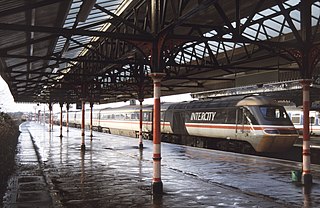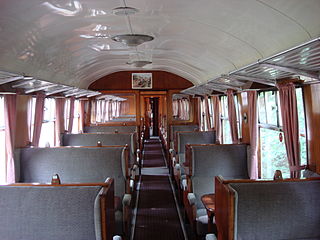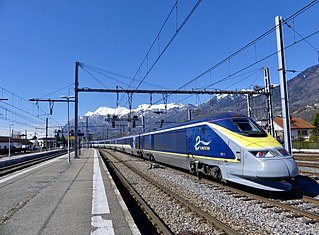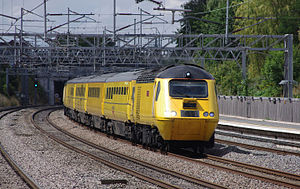
The Advanced Passenger Train (APT) was a tilting high speed train developed by British Rail during the 1970s and early 1980s, for use on the West Coast Main Line (WCML). The WCML contained many curves, and the APT pioneered the concept of active tilting to address these, a feature that has since been copied on designs around the world. The experimental APT-E achieved a new British railway speed record on 10 August 1975 when it reached 152.3 miles per hour (245.1 km/h), only to be surpassed by the service prototype APT-P at 162.2 miles per hour (261.0 km/h) in December 1979.

The InterCity 125 or High Speed Train (HST) is a diesel-powered high-speed passenger train built by British Rail Engineering Limited between 1975 and 1982. A total of 95 sets were produced, each comprising two Class 43 power cars, one at each end, and a rake of seven or eight Mark 3 coaches. The name is derived from its top operational speed of 125 mph (201 km/h). At times, the sets have been classified as British Rail Classes 253, 254 and 255.

InterCity was a brand name introduced by British Rail in 1966 for its long-haul express passenger services.

Class 252 was the classification allocated to the prototype High Speed Train (HST) unit, numbered 252001.

The Blue Pullmans were luxury trains used from 1960 to 1973 by British Rail. They were the first Pullman diesel multiple units, incorporating several novel features.

The InterCity 225 is an electric push-pull high speed train in the United Kingdom, comprising a Class 91 electric locomotive, nine Mark 4 coaches and a Driving Van Trailer (DVT). The Class 91 locomotives were built by British Rail Engineering Limited's Crewe Works as a spin-off from the Advanced Passenger Train project, which was abandoned during the 1980s, whilst the coaches and DVT were constructed by Metro-Cammell in Birmingham and Breda in Italy, again borrowing heavily from the Advanced Passenger Train. The trains were designed to operate at up to 140 mph (225 km/h) in regular service, but are limited to 125 mph (200 km/h) principally due to a lack of cab signalling and the limitations of the current overhead line equipment. They were introduced into service between 1989 and 1991 for intercity services on the East Coast Main Line (ECML) from London King's Cross to Leeds, York and Edinburgh.

The Southall rail crash occurred on 19 September 1997, on the Great Western Main Line at Southall, West London. An InterCity 125 high speed passenger train (HST) failed to slow down in response to warning signals and collided with a freight train crossing its path, causing seven deaths and 139 injuries.

British Rail Mark 1 is the family designation for the first standardised designs of railway carriages built by British Railways (BR) from 1951 until 1974, now used only for charter services on the main lines or on preserved railways.

The Mark 2 family of railway carriages are British Rail's second design of carriages. They were built by British Rail workshops between 1964 and 1975 and were of steel construction.

The British Rail Mark 3 is a type of passenger carriage developed in response to growing competition from airlines and the car in the 1970s. A variant of the Mark 3 became the rolling stock for the High Speed Train (HST).

The British Rail Class 41 were two powercars built in 1972 by British Rail Engineering Limited's Crewe Works to operate with the prototype High Speed Train (HST) with Mark 3 carriages.

The British Rail Class 43 (HST) is the TOPS classification used for the InterCity 125 High Speed Train diesel-electric power cars, built by British Rail Engineering Limited from 1975 to 1982, and in service in the UK since 1976.

The Railway Technical Centre (RTC) in London Road, Derby, England, was the technical headquarters of the British Railways Board and was built in the early 1960s. British Rail described it as the largest railway research complex in the world.

The SNCF TGV Sud-Est was a French high speed TGV train built by Alstom and Francorail-MTE and operated by SNCF, the French national railway company. A total of 111 trainsets were built between 1978 and 1988 for the first TGV service in France between Paris and Lyon which opened in 1981. The trainsets were semi-permanently coupled, consisting of two power cars (locomotives) and eight articulated passenger carriages, ten in the case of the tri-voltage sets. The trains were named after the Ligne à Grande Vitesse Sud-Est that they first operated on. They were also referred to as TGV-PSE, an abbreviation of Paris Sud-Est.

CrossCountry is a British train operating company owned by Arriva UK Trains, operating the current CrossCountry franchise.

The British Rail Class 373, known in France as the TGV TMST and branded by Eurostar as the Eurostar e300, is a French designed and Anglo-French built electric multiple unit train that was used for Eurostar international high-speed rail services from the United Kingdom to France and Belgium through the Channel Tunnel. Part of the TGV family, it was built with a smaller cross-section to fit the smaller loading gauge in Britain, was originally capable of operating on the UK third rail network, and has extensive fireproofing in case of fire in the tunnel. It is both the second longest—387 metres —and second fastest train in regular UK passenger service, operating at speeds of up to 300 kilometres per hour (186 mph).

The British Rail Class 800, branded as the Intercity Express Train (IET) by Great Western Railway (GWR) and Azuma by London North Eastern Railway (LNER) is a type of bi-mode multiple unit train built by Hitachi Rail for GWR and LNER. The type uses electric motors powered from overhead electric wires for traction, but also has diesel generators to enable trains to operate on unelectrified track. It is a part of the Hitachi AT300 product family.

Terence Charles Barry Miller, MBE was an English railway engineer who rose to become Chief Engineer for British Rail.
The 125 Group is a railway heritage group in England dedicated to the preservation of the InterCity 125s.

The Stonehaven derailment was a fatal railway accident that occurred at 09:38 BST on 12 August 2020, when a passenger train returning to Aberdeen hit a landslip, near Carmont, west of Stonehaven in Aberdeenshire, Scotland, following severe rain. Of the nine people aboard, three were killed, and six were injured.




















